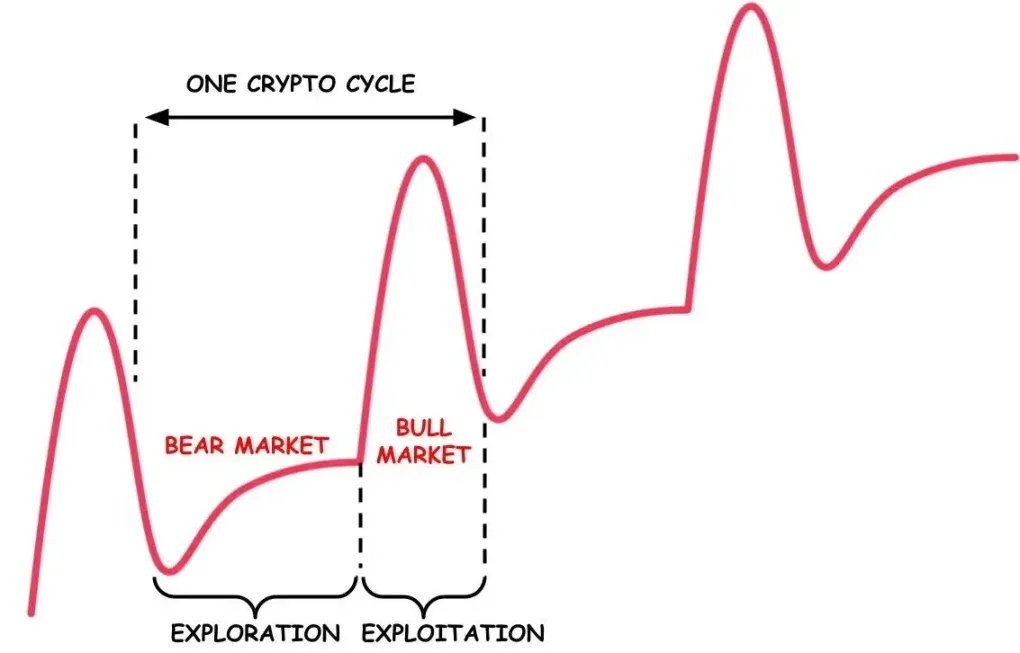Breaking the “Four-Year Cycle” Myth: The Key to Crypto’s Evolution

Recently, I shared some thoughts on Crypto Twitter (CT), which sparked intense debate in the community. I wasn’t sure if critics misunderstood my views or if I had struck a nerve with CT’s vested interests.

That’s not to say that useful investment advice can’t occasionally be found on CT. It’s a novel form of information overload, like an endless soap opera, where the storylines and villains are absurd. It’s more of an entertainment hub than a serious space for financial insight.
This experience got me reflecting on the current state of crypto. At some point, I realized that crypto is already mainstream. While it may not be mainstream in terms of adoption, it’s certainly a part of mainstream entertainment. How many people around you haven’t heard of cryptocurrency? Today, crypto is even a hot topic in the U.S. presidential election. How could it not be mainstream?
People love being “early birds,” deceiving themselves into thinking that getting in early guarantees profits. Participation seems like a prerequisite for success, and CT reinforces this belief as a false prophet. This is the “alpha,” that’s the “alpha”… CT has become a reality show where tokens are the form of entertainment.
CT is neither good nor bad for the industry; it’s just a reflection of crypto’s mainstreamification. From humble beginnings as a movement of anarcho-capitalism to a peak of idealism, crypto is now going through its “TikTok-ification,” packaged for consumers in ways that Satoshi likely never imagined.

As one prominent CT figure once said, “It’s hard to distinguish between the signs of a bubble and mainstream adoption.” The problem with mainstream adoption is that you lose the early-mover advantage.
The Myth of the Four-Year Cycle
Crypto has adopted its own version of a predestined cultural myth. Whether you’re a Bitcoin maximalist, ETH believer, or SOL supporter, many subscribe to the myth of the “four-year cycle.” Almost everyone believes that crypto is destined to grow, with a bull market magically appearing every four years to lead us into a land of riches.
But as the industry grows, imitation and recycling become more valuable than innovation. The crypto space now clings to the four-year cycle narrative, perpetuating the idea that being early is an advantage. This will eventually change. Participation may no longer be enough. Complacency will catch up.

Necessity is the mother of invention, but unfortunately, much of the capital in the space is focused on short-term gains (price pumps), while savvy founders know how to play the VC game. Over the past two years, there’s been neither demand nor any trigger for genuine innovation.
This is why the crypto industry has turned to macroeconomic interventions as a lifeline, whether it’s rate cuts or a new government administration. We hope for capital inflows from top-down initiatives (like ETFs) rather than from bottom-up innovation. The problem is that this game will eventually collapse.
Currently, VCs are finding it difficult to raise new funds, and the VC industry is facing scrutiny for its declining returns. Crypto is no different, with the key difference being that crypto LPs saw returns around 2021. This time, that won’t happen again, as funds touting paper gains are quickly being wiped out.
What Is the Savior?
Treating financial anomalies as the only path forward, hoping that a bigger fool will come along to save us, shows how far we’ve fallen. The issue is that most people don’t even bother hiding it anymore. I’ve never seen anything like this: everyone standing at the edge of a bull market, eager to sell off as quickly as possible.
The notion of a “four-year cycle” in crypto must be destroyed if the industry is to cross the chasm and become something truly new. As long as this idea persists, the default incentives remain:
- Prioritizing short-term behaviors (both for builders and investors)
- Perpetuating the greater fool theory, where people believe the current cycle will inevitably collapse.
With easy-to-implement ideas being adopted, crypto is becoming a zero-sum game. Founders and “communities” celebrate massive funding rounds without any real product, declaring victory for simply raising money. While projects like X and Y have secured funding, they hide the fact that there is no real technical innovation like we saw in previous cycles (such as DeFi).
Aside from foolishly hoping someone else will come along to take over, what do we really believe in? Do we trust CT? It’s just an amplifier of emotions. Do we believe in alpha, or are we simply buying into self-deceptive narratives?
What Are We Left With?
All we have left is the narrative. We force ourselves to believe in stories we don’t really trust, hoping others will. But without a narrative, there can be no bull market, no adoption! Yes, but narratives only work best when they’re not treated as narratives.
True narratives aren’t manufactured on Twitter. They are forged through innovation, inspiring people’s enthusiasm, which then turns into arrogant hubris. That’s what creates fervor, and fervor must have a foundation. We don’t have that foundation; we only want to spread hollow narratives, using memes and Twitter to turn them into reality.
I’ve made this mistake myself—covering up product flaws by shouting “culture!” at the top of my lungs is not a valid approach. The only culture we’ve cultivated is one of empty narratives and toxic community behavior, which is only as powerful as price performance.
But maybe we shouldn’t underestimate the predictability of stupidity. After all, hasn’t stupidity always kept us from extinction? Or perhaps, somewhere in the background, a major innovation is quietly brewing?
I don’t have the answers. I suspect that if the market doesn’t reach new heights, we’ll enter uncharted territory—painful in the short to mid-term, but ultimately beneficial for crypto innovation.